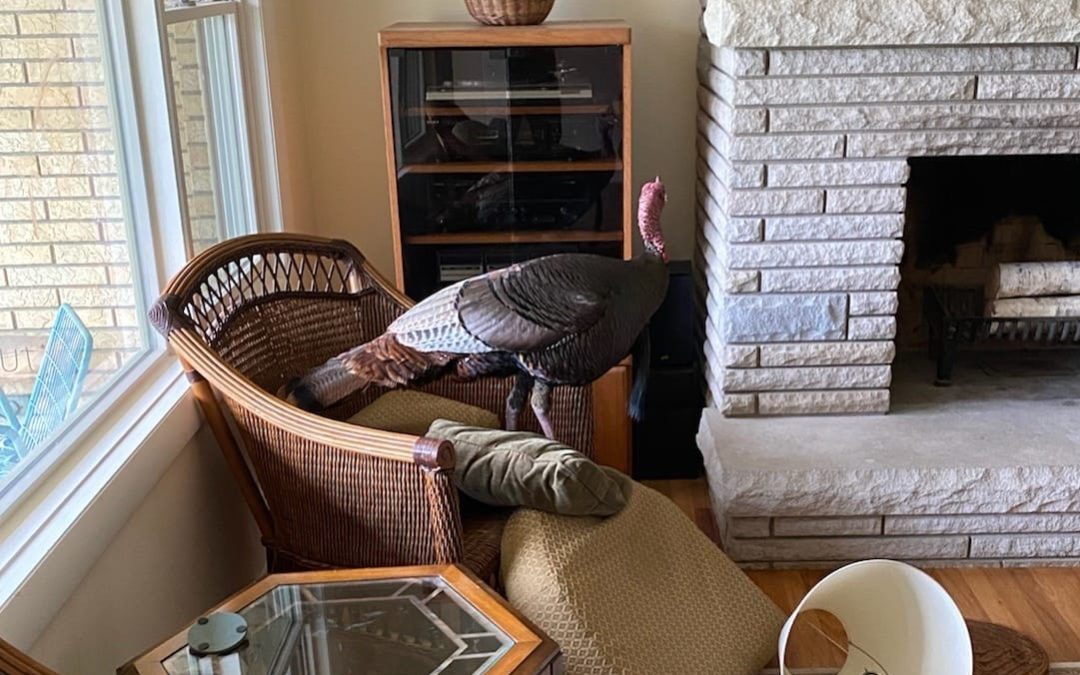Most of us don’t think about what our homeowners policy covers, until we have a reason to file a claim. Recently, our client sent this photo and asked if the destruction the wild turkey caused to his home was covered. In this case, the wild turkey broke through our client’s window and entered the house. The broken window may be covered, but not the damage the bird caused inside the home. Damage caused by birds, insects, and vermin is never covered by homeowners insurance.
Homeowners insurance can be complicated. In fact, there are multiple policy types and levels of coverage, so it’s important to work with a personal insurance advisor to craft the right policy for your situation.
At the end of the day, the type of homeowners insurance policy that will be right for you will depend on a number of factors, including:
- The type of structure you’re covering
- The age and condition of the structure
- The types of coverage you want or need
- The requirements of your mortgage lender (if applicable)
Types of Home Insurance Policies
For most homeowners, an HO-3 or HO-5 should provide adequate coverage. HO-2 policies are uncommon. Most insurance companies only write an HO-2 if they deem the risk presented by you and your property to be too great for a higher-level policy. An HO-2 policy can leave you and your belongings vulnerable to many unnamed perils.
Most renters, meanwhile, should be well-covered by an HO-4. If you own a condo or co-op then an HO-6 will likely make the most sense for you, while an HO-7 provides coverage for mobile homes. Older homes that do not qualify for coverage under an HO-3 or HO-5, such as historical landmarks, may need to purchase coverage under an HO-8 policy.
Below is a chart that lists the perils covered by the various homeowner policy levels:

What type of damage is NOT covered?
Your home insurance policy outlines exactly which perils are and are not covered.
Here’s an example of perils that are never covered:
- Earthquake
- Flooding
- Pests
- Routine wear and tear or age
While most homeowner policies cover water damage that is sudden and accidental, like damage from burst pipes or water heaters, flooding from a natural source requires a separate flood insurance policy.
In fact, the potential cost of recovery from flood damage is so high that only the Federal government provides flood insurance.
Want to make sure you have the coverage you need and the right endorsements in place?
Start by scheduling a personal insurance review with your agent. Reviewing your policy will help make sure your property is covered for the right amount as well as specific types of events.
There are many different home insurance endorsements that can be added to your policy, but some of the most common include the following:
Scheduled personal property. Scheduled personal property (or itemized personal property) is an optional coverage you can add to your home insurance policy that not only provides more coverage for your higher valued items, but also for a greater number of risks than already listed on your policy.
A great example of scheduling personal property is adding extra coverage for your jewelry. Having an endorsement for your jewelry not only gives you a higher level of coverage to meet your needs, but you’ll also be covered for events that are excluded from your basic homeowners policy. For instance, are you worried about losing your jewelry? If your ring goes missing, having it insured with this endorsement can help cover the replacement cost — whereas your basic home insurance policy won’t cover it if it gets lost.
Home business coverage. Limited home business coverage is an optional coverage that small home-based business owners can add to an existing homeowners insurance policy. By adding this coverage, you’re extending the same liability limits and coverages of your personal home insurance to your small business.
Sewer backup and sump pump overflow. Your sump pump is designed to remove excess water that accumulates around your home’s foundation. If the system ever fails or the power goes out, water overflow may occur. And you’re typically not covered for this type of damage with your homeowners insurance. Having water backup and sump pump overflow coverage gives you that important layer of protection.
Identity theft protection. Identity theft not only comes with financial loss, but you’ll probably have a lot of issues to resolve, like restoring your credit and financial reputation. Identity theft insurance offers restoration services to help make the process easier on you and your family.
Levels of homeowners insurance coverage
If you have a fire in your home, does your homeowners policy have actual cash value coverage or replacement cost coverage for the dwelling and the contents?
Just about every type of homeowners insurance policy provides the same basic coverages, but the amount you’re paid out or reimbursed for property damage or theft will vary depending on which level of coverage you have. While coverage availability varies by company and policy type, there are generally four different coverage levels in homeowners insurance:
-
Actual cash value: This is the cheapest level of coverage but it subtracts depreciation (like the property’s age or condition) from your claim payout, leaving you paying more out of pocket on a claim if your home is damaged.
-
Replacement cost value: This is more expensive than actual cash value, but you’re reimbursed for the cost of repairing or rebuilding your home to its original condition before it was damaged.
-
Extended replacement cost: A more costly level of coverage than replacement cost, but it increases your coverage by a capped amount (like 25% or 50%) if your home is damaged and your policy limit isn’t high enough.
-
Guaranteed replacement cost: The most expensive level of coverage, but it reimburses you for a full rebuild regardless of the cost.
Questions about your homeowners policy? Schedule a policy review. Let’s Talk.
About the Authors

Connie Greenwood has over 35 years of experience as an Insurance Advisor. She enjoys helping her clients and prospects understand their insurance options, and crafting insurance solutions tailored to their unique needs. Connie finds great joy in being a trusted advisor for her clients. She loves helping protect their financial welfare against unforeseen accidents and circumstances and bringing them peace of mind.

Tim Pingel has over 20 years of experience as a personal insurance adviser. He provides individuals, couples, and families with home, auto, and umbrella insurance. His ultimate goal is to be his clients’ trusted adviser and expert, so they have the peace of mind and protection they deserve.


Recent Comments